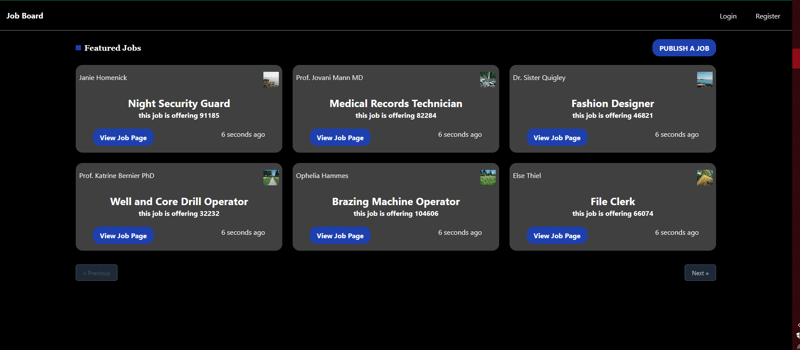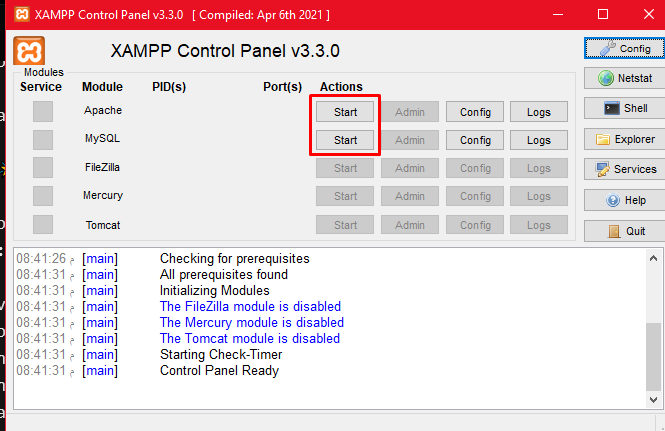Setting Up A Development Environment For Laravel
? Setting Up Your Laravel Development Environment on Windows ?️
Hey Devs! ?
Welcome to my new series where I’ll be diving into the world of Laravel! ? As I’m learning Laravel myself, I’m excited to share the knowledge and insights I’ve gathered so far. My goal is to help you break into Laravel development smoothly and efficiently. ?
I believe in the power of shared learning, so this series will not only guide you through the setup but also evolve over time. I might revisit and improve upon the content based on new discoveries or feedback. Who knows? We might uncover even better practices together! ?
The end goal of this series is to build a beautiful job board where users could submit job postings, it's packed with features and will cover many key concepts like MVC architecture, authentication, authorization, policies, styling and templating and more!!


With all that being said it's time to dive into the world of Laravel on a Windows machine, Whether you're starting fresh or setting up a new project, this guide will walk you through the essentials of getting your Laravel development environment up and running. Let’s get started! ?
? But why Choose Laravel?
Laravel is your gateway to rapid, robust, and modern web development. ? Here's why it’s a game-changer:
Elegant Syntax: Laravel’s syntax is clean and expressive, making coding a joy and boosting productivity.
Built-in Tools: From authentication and routing to caching and sessions, Laravel comes with a suite of tools that save you time.
Active Community: Laravel boasts a vibrant community and extensive documentation, so help is always at your fingertips.
Scalability & Security: Laravel provides powerful features to scale your apps and keep them secure.
In a nutshell, Laravel empowers you to build high-quality applications quickly and efficiently. Why wait? Dive in and see the magic for yourself! ? ( literal black magic, the framework is just that inelegant and knows what the dev wants )
1. ?️ Download and Install XAMPP
XAMPP is your go-to solution for setting up a local server environment. It includes Apache, MySQL, and PHP—all the goodies you need to run Laravel.
- Download XAMPP: Head over to XAMPP’s official website and grab the latest version for Windows.
- Install XAMPP: Run the installer and follow the prompts. Make sure Apache and MySQL are selected during installation as these are crucial for Laravel.
2. ? Install Composer
Composer is a powerful dependency manager for PHP that Laravel relies on. Here’s how to get it:
- Download Composer: Visit Composer’s website and download the Composer-Setup.exe file.
- Install Composer: Run the installer and follow the instructions. During setup, ensure that the installer finds the PHP executable from your XAMPP installation.
3. ? Create a New Laravel Project
Now that you have XAMPP and Composer ready, it’s time to create your Laravel project!
- Open Command Prompt: Navigate to where you want to create your Laravel project.
- Run Composer Command: Execute the following command to create a new Laravel project:
composer create-project laravel/laravel my-laravel-app
Replace my-laravel-app with your desired project name ( job-board in our case )
4. ? Setting Up Your Environment
Once your Laravel project is created, you’ll need to configure a few things:
- Navigate to Your Project Directory: Use cd my-laravel-app to go into your project directory.
- Run Laravel Development Server: Start the built-in Laravel server by running:
php artisan serve
This will start a local development server at http://127.0.0.1:8000.
quick note: make sure that your server and db are running by pressing start on your xampp control panel for your server and db

5. ? Additional Tips
- Database Configuration: Open .env in your Laravel project and configure your database settings to match your MySQL setup in XAMPP.
- Check Dependencies: Regularly update your project’s dependencies by running composer update.
? You’re All Set!
Congratulations! ? You’ve successfully set up a Laravel development environment on Windows. Now you're ready to start building amazing applications!
Feel free to drop any questions or share your experiences in the comments.
Happy coding! ??
The above is the detailed content of Setting Up A Development Environment For Laravel. For more information, please follow other related articles on the PHP Chinese website!

Hot AI Tools

Undresser.AI Undress
AI-powered app for creating realistic nude photos

AI Clothes Remover
Online AI tool for removing clothes from photos.

Undress AI Tool
Undress images for free

Clothoff.io
AI clothes remover

Video Face Swap
Swap faces in any video effortlessly with our completely free AI face swap tool!

Hot Article

Hot Tools

Notepad++7.3.1
Easy-to-use and free code editor

SublimeText3 Chinese version
Chinese version, very easy to use

Zend Studio 13.0.1
Powerful PHP integrated development environment

Dreamweaver CS6
Visual web development tools

SublimeText3 Mac version
God-level code editing software (SublimeText3)

Hot Topics
 1664
1664
 14
14
 1421
1421
 52
52
 1315
1315
 25
25
 1266
1266
 29
29
 1239
1239
 24
24
 PHP and Python: Comparing Two Popular Programming Languages
Apr 14, 2025 am 12:13 AM
PHP and Python: Comparing Two Popular Programming Languages
Apr 14, 2025 am 12:13 AM
PHP and Python each have their own advantages, and choose according to project requirements. 1.PHP is suitable for web development, especially for rapid development and maintenance of websites. 2. Python is suitable for data science, machine learning and artificial intelligence, with concise syntax and suitable for beginners.
 PHP in Action: Real-World Examples and Applications
Apr 14, 2025 am 12:19 AM
PHP in Action: Real-World Examples and Applications
Apr 14, 2025 am 12:19 AM
PHP is widely used in e-commerce, content management systems and API development. 1) E-commerce: used for shopping cart function and payment processing. 2) Content management system: used for dynamic content generation and user management. 3) API development: used for RESTful API development and API security. Through performance optimization and best practices, the efficiency and maintainability of PHP applications are improved.
 Explain secure password hashing in PHP (e.g., password_hash, password_verify). Why not use MD5 or SHA1?
Apr 17, 2025 am 12:06 AM
Explain secure password hashing in PHP (e.g., password_hash, password_verify). Why not use MD5 or SHA1?
Apr 17, 2025 am 12:06 AM
In PHP, password_hash and password_verify functions should be used to implement secure password hashing, and MD5 or SHA1 should not be used. 1) password_hash generates a hash containing salt values to enhance security. 2) Password_verify verify password and ensure security by comparing hash values. 3) MD5 and SHA1 are vulnerable and lack salt values, and are not suitable for modern password security.
 PHP: A Key Language for Web Development
Apr 13, 2025 am 12:08 AM
PHP: A Key Language for Web Development
Apr 13, 2025 am 12:08 AM
PHP is a scripting language widely used on the server side, especially suitable for web development. 1.PHP can embed HTML, process HTTP requests and responses, and supports a variety of databases. 2.PHP is used to generate dynamic web content, process form data, access databases, etc., with strong community support and open source resources. 3. PHP is an interpreted language, and the execution process includes lexical analysis, grammatical analysis, compilation and execution. 4.PHP can be combined with MySQL for advanced applications such as user registration systems. 5. When debugging PHP, you can use functions such as error_reporting() and var_dump(). 6. Optimize PHP code to use caching mechanisms, optimize database queries and use built-in functions. 7
 What are HTTP request methods (GET, POST, PUT, DELETE, etc.) and when should each be used?
Apr 09, 2025 am 12:09 AM
What are HTTP request methods (GET, POST, PUT, DELETE, etc.) and when should each be used?
Apr 09, 2025 am 12:09 AM
HTTP request methods include GET, POST, PUT and DELETE, which are used to obtain, submit, update and delete resources respectively. 1. The GET method is used to obtain resources and is suitable for read operations. 2. The POST method is used to submit data and is often used to create new resources. 3. The PUT method is used to update resources and is suitable for complete updates. 4. The DELETE method is used to delete resources and is suitable for deletion operations.
 Explain the difference between self::, parent::, and static:: in PHP OOP.
Apr 09, 2025 am 12:04 AM
Explain the difference between self::, parent::, and static:: in PHP OOP.
Apr 09, 2025 am 12:04 AM
In PHPOOP, self:: refers to the current class, parent:: refers to the parent class, static:: is used for late static binding. 1.self:: is used for static method and constant calls, but does not support late static binding. 2.parent:: is used for subclasses to call parent class methods, and private methods cannot be accessed. 3.static:: supports late static binding, suitable for inheritance and polymorphism, but may affect the readability of the code.
 How does PHP handle file uploads securely?
Apr 10, 2025 am 09:37 AM
How does PHP handle file uploads securely?
Apr 10, 2025 am 09:37 AM
PHP handles file uploads through the $\_FILES variable. The methods to ensure security include: 1. Check upload errors, 2. Verify file type and size, 3. Prevent file overwriting, 4. Move files to a permanent storage location.
 How does PHP type hinting work, including scalar types, return types, union types, and nullable types?
Apr 17, 2025 am 12:25 AM
How does PHP type hinting work, including scalar types, return types, union types, and nullable types?
Apr 17, 2025 am 12:25 AM
PHP type prompts to improve code quality and readability. 1) Scalar type tips: Since PHP7.0, basic data types are allowed to be specified in function parameters, such as int, float, etc. 2) Return type prompt: Ensure the consistency of the function return value type. 3) Union type prompt: Since PHP8.0, multiple types are allowed to be specified in function parameters or return values. 4) Nullable type prompt: Allows to include null values and handle functions that may return null values.




